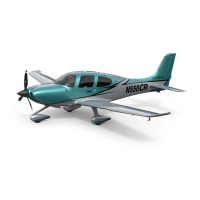
Do you have a question about the CIRRUS DESIGN SR22 and is the answer not in the manual?
| Brand | CIRRUS DESIGN |
|---|---|
| Model | SR22 |
| Category | Tools |
| Language | English |
Specifies critical airspeed limits for safe operation.
Specifies critical weight limits for takeoff and baggage.
Defines the critical center of gravity envelope for safe operation.
Describes limitations related to the aircraft's parachute system.
Lists critical airspeeds for various emergency operations.
Lists critical emergency procedure steps that must be memorized.
Details procedures for handling emergencies on the ground.
Procedure for handling an engine fire during the start sequence.
Procedure for safely shutting down the engine on the ground.
Procedure for safe and rapid exit from the aircraft.
Details procedures for handling emergencies during flight.
Procedure for engine failure immediately after becoming airborne.
Provides data and guidance for maximum glide performance.
Procedure for handling engine failure at altitude.
Procedure for handling a partial loss of engine power.
Procedure for handling an engine fire during flight.
Procedure for executing a rapid descent.
Information on spin characteristics and recovery procedures.
Detailed procedures for activating the Cirrus Airframe Parachute System.
Procedures for handling various landing emergencies.
Procedure for forced landing without engine power.
Procedure for loss of air data on the Primary Flight Display.
Procedure for loss of attitude data on the Primary Flight Display.
Procedure for handling brake failure during taxi operations.
Procedure for aborting a takeoff safely.
Procedure for encountering icing conditions unexpectedly.
Procedure for landing with inoperative brakes.
Procedure for a malfunction in the pitot-static system.
Procedure for failure of the electric trim or autopilot system.
Essential pre-flight task to ensure aircraft readiness.
Detailed checklist for the external pre-flight inspection.
Procedures to follow before starting the aircraft engine.
Critical procedure for starting the aircraft engine.
Critical procedure for a standard takeoff.
Critical procedure for takeoff from short fields.
Critical procedure for a standard landing.
Critical procedure for landing on short fields.
Critical procedure for aborting a landing.
Knowledge of stall characteristics and recovery techniques.
Information for predicting airplane performance for flight planning.
Provides takeoff performance data including ground roll and distance.
Provides climb performance data including rate and gradient.
Calculates total fuel requirement for a flight based on performance data.
Provides landing performance data including ground roll and distance.
Lists critical stall speeds for various configurations and conditions.
Provides data on time, fuel, and distance for climbing.
Guidance for properly loading the airplane within weight limits.
Defines the critical center of gravity envelope for safe operation.
Detailed description of the PFD and its functions.
Details of integrated seat belts and shoulder harnesses.
Description and operation of the Halon fire extinguisher.
Description of the Teledyne Continental IO-550-N engine.
Describes the wet-wing fuel storage and delivery system.
Explains the amber fuel caution light for low fuel conditions.
Describes the hydraulic brake system and its components.
Describes the 28-VDC electrical system with two alternators and batteries.
Describes the function of the master switches for batteries and alternators.
Explains the red warning light for low voltage on the Essential Bus.
Describes the caution lights for alternator failure or overcurrent.
Describes the electro-pneumatic stall warning system.
Describes the Avidyne EX5000C Multi-Function Display.
Describes the S-TEC System 55X Autopilot system.
Describes the self-contained emergency locator transmitter (ELT).
Describes the CAPS designed for emergency landings.
Describes the procedure for activating the CAPS T-handle.
Describes the expected characteristics of CAPS deployment.
Defines required inspection intervals for aircraft.
Details requirements for the mandatory annual inspection.
Details requirements for the 100-hour inspection.
Critical maintenance procedures for the brake system.
Critical maintenance procedure for engine oil.
Critical maintenance procedures for the fuel system.
Critical safety procedure for checking fuel quality.
Describes how to power on and the fail-safe operation of the audio panel.
Explains the function of the transponder mode selector keys.
Describes the autopilot system and its features.
Procedure for handling an autopilot malfunction.
Critical pre-flight checks for the autopilot and altitude selector.
Describes the autopilot's Altitude Hold mode operation.
Describes the autopilot's Vertical Speed mode operation.
Procedures for autopilot navigation using GPS.
Procedures for autopilot glideslope capture and tracking.
Procedure for handling unexpected encounters with icing conditions.
Actions to take when ground proximity warnings occur.
Actions to take for terrain and obstacle awareness alerts.
Critical operational limitations for the Flight Director system.
Critical operational limits for the XM Satellite Weather System.
Procedure for cabin fire with air conditioner ON.
Procedure for alternator failure with air conditioner ON.
Procedure for low voltage warning with AC ON.
Procedure before takeoff concerning the air conditioner.
Critical maintenance procedures for the propeller spinner and blades.
Provides takeoff distance data for various conditions.
Information on weight and balance for G3 Wing airplanes.
Detailed procedures for weighing the aircraft and determining CG.
Chart to determine if weight and moment are within limits.
Form to calculate total weight and moment for loading.
Detailed information on CAPS deployment scenarios and considerations.
Provides critical considerations for landings after CAPS deployment.
Critical procedure for occupant protection during touchdown.
